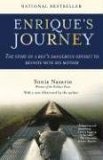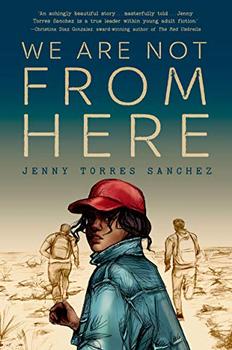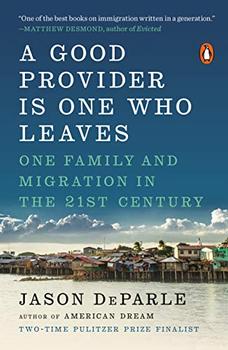Summary | Excerpt | Reading Guide | Reviews | Beyond the book | Read-Alikes | Genres & Themes | Author Bio

From the book jacket: In this astonishing true story, award-winning journalist Sonia Nazario recounts the unforgettable odyssey of a Honduran boy who braves unimaginable hardship and peril to reach his mother in the United States.
When Enrique is five years old, his mother, Lourdes, too poor to feed her children, leaves Honduras to work in the United States. The move allows her to send money back home to Enrique so he can eat better and go to school past the third grade.
Lourdes promises Enrique she will return quickly. But she struggles in America. Years pass. He begs for his mother to come back. Without her, he becomes lonely and troubled. When she calls, Lourdes tells him to be patient. Enrique despairs of ever seeing her again. After eleven years apart, he decides he will go find her.
Comment: Enrique's story began when he was 5-years-old, living in Tegucigalpa, the capital of
Honduras, with his mother, Lourdes, who is barely able to support him and his sister by selling tortillas and gum on the street.
One day she sees pictures of Las Vegas on a customer's TV screen; it's a revelation
- if only she could find this promised land she could earn enough money to save her children from
poverty. However, she can't take them with her so, like thousands before
and after her, she makes the hard choice to leave, not even taking a photograph of her beloved children
(who she leaves in the care of relatives)
because it would make her too sad. She plans to make some money and return
in a couple of years.
Lourdes succeeds in crossing into the USA but finds life much more difficult than
she hoped. She manages to send money home religiously but is never
able to save enough to return herself. Eleven years later, Enrique, sad
and increasingly bitter at being abandoned, follows her north with just a
telephone number and $57 in his pocket, determined to
find the woman he idolizes. His journey takes him across four borders (from Honduras to Guatamala to Mexico and finally
into the USA).
He has barely boarded the train out of Tegucigalpa before he is assaulted by men
who try to lynch him,
then beat him up and throw him from the train. He staggers barefoot down
the tracks trying to find help but no one will come to his aid. This is
just a taste of what will come. He travels on the top of the speeding
freight trains that migrants call el Tren de la Muerte (the train of death)
which regularly claim the lives and limbs of those who attempt the journey (pictures
on Nazario's website). Before he finally reaches his mother he will
have been beaten by gangs, endured extreme exposure to both heat and cold, been
repeatedly arrested by police and immigration officers in multiple countries and
spent weeks begging for food and water. He attempts the journey north
seven times, traveling for a total of
122 days and more than 12,000 miles. On his eighth attempt he finally makes it
across the US border, but after such a long separation the meeting between
Lourdes and Enrique in North Carolina can only be a disappointment; both mother
and son have idolized each other for so long that nothing can live up to either
of their dreams and the reunion sparks resentments that have quietly festered
for years.
Few would disagree that illegal immigration is a problem for the USA and for
other Western countries, but it's all too easy to think of it as a statistical
problem, not the human problem that it is. At the end of the day
Enrique's Journey is not about illegal immigration or people stealing jobs
from USA workers, it's about families, and the desperately hard choices that too many have to make.
How Nazario researched Enrique's Journey:
A condensed version of Enrique's Journey was published in
the Los Angeles Times in 2003, but the idea for the book was planted 6 years
before that when journalist Nazario sat down for a cup of coffee with Carmen,
her Guatemalan housekeeper, and learned that Carman had left four
children behind when she migrated north a decade before. What shocked
Nazario more than Carman's personal saga was the realization that her experience
was unexceptional. With divorce spreading across Latin America and
families disintegrating, the face of migration had changed dramatically (see
side bar).
In 2000, Nazario met Enrique in Nuevo Laredo, Mexico where he was
being cared for by a humanitarian group who look after imprisoned illegal
immigrants. According to Nazario, the majority of Mexicans live by a double standard whereby its perfectly acceptable
for them to enter the USA illegally to find work, but they are unwilling to give
sanctuary, even temporarily, to those entering their country from the south;
however there are exceptions to this norm, such as the group who
helped Enrique. Later, after Lourdes and Enrique have been reunited, she
spent a number of weeks with them in North Carolina. From
there she flew to Honduras to follow the migrant trail herself through Guatemala and Mexico.
She boarded the same train that Enrique had traveled on and spent months living
on her wits in order to live Enrique's journey for herself.
Honduras vs USA
![]() This review was originally published in The BookBrowse Review in March 2006, and has been updated for the
February 2007 edition.
Click here to go to this issue.
This review was originally published in The BookBrowse Review in March 2006, and has been updated for the
February 2007 edition.
Click here to go to this issue.

If you liked Enrique's Journey, try these:

by Jenny Torres Sanchez
Published 2021
Winner of the 2020 BookBrowse Award for Best Young Adult Novel
A poignant novel of desperation, escape, and survival across the U.S.-Mexico border, inspired by current events.

A Good Provider Is One Who Leaves
by Jason DeParle
Published 2020
The definitive chronicle of our new age of global migration, told through the multi-generational saga of a Filipino family, by a veteran New York Times reporter and two-time Pulitzer Prize finalist.
Your guide toexceptional books
BookBrowse seeks out and recommends the best in contemporary fiction and nonfiction—books that not only engage and entertain but also deepen our understanding of ourselves and the world around us.